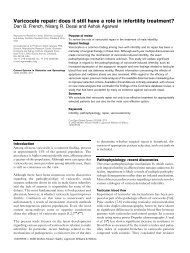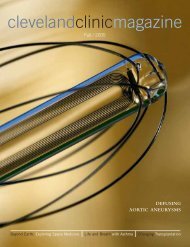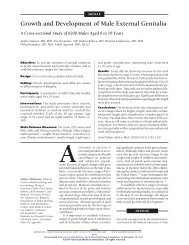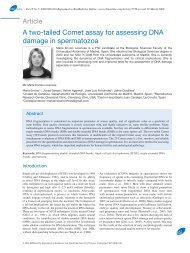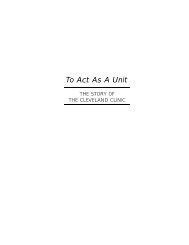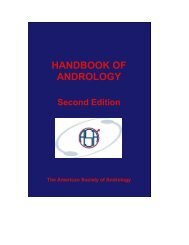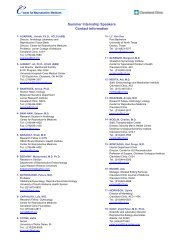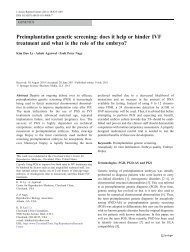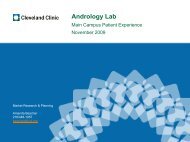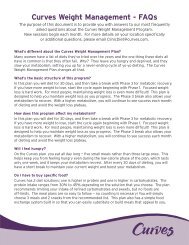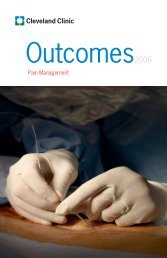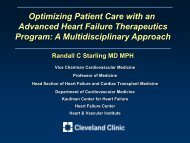Artificial Insemination
Artificial Insemination
Artificial Insemination
Create successful ePaper yourself
Turn your PDF publications into a flip-book with our unique Google optimized e-Paper software.
Ch36-A03309.qxd 1/23/07 5:16 PM Page 548<br />
Section 6<br />
Infertility and Recurrent Pregnancy Loss<br />
45. Bedaiwy MA, Sharma RK, Alhussaini TK, et al: The use of novel semen<br />
quality scores to predict pregnancy in couples with male-factor infertility<br />
undergoing intrauterine insemination. J Androl 24:353–360, 2003.<br />
46. Hendin BN, Falcone T, Hallak J, et al: The effect of patient and semen<br />
characteristics on live birth rates following intrauterine insemination: A<br />
retrospective study. J Assist Reprod Genet 17:245–252, 2000.<br />
47. Zayed F, Lenton EA, Cooke ID: Comparison between stimulated in<br />
vitro fertilization and stimulated intrauterine insemination for the<br />
treatment of unexplained and mild male factor infertility. Hum Reprod<br />
12:2408–2413, 1997.<br />
48. Van Waart J, Kruger TF, Lombard CJ, Ombelet W: Predictive value of<br />
normal sperm morphology in intrauterine insemination (IUI): A<br />
structured literature review. Hum Reprod Update 7:495–500, 2001.<br />
49. van Noord-Zaadstra BM, Looman CW, Alsbach H, et al: Delaying childbearing:<br />
Effect of age on fecundity and outcome of pregnancy. BMJ<br />
302:1361–1365, 1991.<br />
50. Stone BA, Vargyas JM, Ringler GE, et al: Determinants of the outcome<br />
of intrauterine insemination: Analysis of outcomes of 9963 consecutive<br />
cycles. Am J Obstet Gynecol 180:1522–1534, 1999.<br />
51. Campana A, Sakkas D, Stalberg A, et al: Intrauterine insemination:<br />
Evaluation of the results according to the woman’s age, sperm quality,<br />
total sperm count per insemination and life table analysis. Hum Reprod<br />
11:732–736, 1996.<br />
52. Richthoff J, Spano M, Giwercman YL, et al: The impact of testicular<br />
and accessory sex gland function on sperm chromatin integrity as<br />
assessed by the sperm chromatin structure assay (SCSA). Hum Reprod<br />
17:3162–3169, 2002.<br />
53. Saleh RA, Agarwal A, Nada EA, et al: Negative effects of increased<br />
sperm DNA damage in relation to seminal oxidative stress in men<br />
with idiopathic and male factor infertility. Fertil Steril 79(Suppl 3):<br />
1597–1605, 2003.<br />
54. Bungum M, Humaidan P, Spano M, et al: The predictive value of sperm<br />
chromatin structure assay (SCSA) parameters for the outcome of<br />
intrauterine insemination, IVF and ICSI. Hum Reprod 19:1401–1408,<br />
2004.<br />
55. Duran EH, Morshedi M, Taylor S, Oehninger S: Sperm DNA quality<br />
predicts intrauterine insemination outcome: A prospective cohort study.<br />
Hum Reprod 17:3122–3128, 2002.<br />
56. Tartagni M, Schonauer MM, Cicinelli E, et al: Usefulness of the hypoosmotic<br />
swelling test in predicting pregnancy rate and outcome in<br />
couples undergoing intrauterine insemination. J Androl 23:498–502,<br />
2002.<br />
57. Ombelet W, Deblaere K, Bosmans E, et al: Semen quality and intrauterine<br />
insemination. Reprod Biomed Online 7:485–492, 2003.<br />
58. Ohl DA, Naz RK: Infertility due to antisperm antibodies. Urology<br />
46:591–602, 1995.<br />
59. McLachlan RI: Basis, diagnosis and treatment of immunological infertility<br />
in men. J Reprod Immunol 57:35–45, 2002.<br />
60. Lombardo F, Gandini L, Dondero F, Lenzi A: Antisperm immunity in<br />
natural and assisted reproduction. Hum Reprod Update 7:450–456,<br />
2001.<br />
61. Dickey RP, Olar TT, Taylor SN, et al: Relationship of follicle number,<br />
serum estradiol, and other factors to birth rate and multiparity in human<br />
menopausal gonadotropin-induced intrauterine insemination cycles. Fertil<br />
Steril 56:89–92, 1991.<br />
62. Dickey RP, Olar TT, Taylor SN, et al: Relationship of follicle number and<br />
other factors to fecundability and multiple pregnancy in clomiphene<br />
citrate-induced intrauterine insemination cycles. Fertil Steril 57:613–619,<br />
1992.<br />
63. Mathieu C, Ecochard R, Bied V, et al: Cumulative conception rate<br />
following intrauterine artificial insemination with husband’s spermatozoa:<br />
Influence of husband’s age. Hum Reprod 10:1090–1097, 1995.<br />
64. Tomlinson MJ, Amissah-Arthur JB, Thompson KA, et al: Prognostic<br />
indicators for intrauterine insemination (IUI): Statistical model for IUI<br />
success. Hum Reprod 11:1892–1896, 1996.<br />
65. Steures P, van der Steeg JW, Mol BW, et al: Prediction of an ongoing<br />
pregnancy after intrauterine insemination. Fertil Steril 82:45–51, 2004.<br />
66. Haebe J, Martin J, Tekepety F, et al: Success of intrauterine insemination<br />
in women aged 40–42 years. Fertil Steril 78:29–33, 2002.<br />
67. Khalil MR, Rasmussen PE, Erb K, et al: Homologous intrauterine<br />
insemination. An evaluation of prognostic factors based on a review of<br />
2473 cycles. Acta Obstet Gynecol Scand 80:74–81, 2001.<br />
68. Tsai HD, Chang CC, Hsieh YY, et al: <strong>Artificial</strong> insemination. Role of endometrial<br />
thickness and pattern, of vascular impedance of the spiral and<br />
uterine arteries, and of the dominant follicle. J Reprod Med 45:195–200,<br />
2000.<br />
69. Zollner U, Zollner KP, Blissing S, et al: Impact of three-dimensionally<br />
measured endometrial volume on the pregnancy rate after intrauterine<br />
insemination. Zentralbl Gynakol 125:136–141, 2003.<br />
70. Krediet CT, van Dijk N, Linzer M, et al: Management of vasovagal<br />
syncope: Controlling or aborting faints by leg crossing and muscle tensing.<br />
Circulation 106:1684–1689, 2002.<br />
71. Smith YR, Hurd WW, Menge AC, et al: Allergic reactions to penicillin<br />
during in vitro fertilization and intrauterine insemination. Fertil Steril<br />
58:847–849, 1992.<br />
72. Sonenthal KR, McKnight T, Shaughnessy MA, et al: Anaphylaxis during<br />
intrauterine insemination secondary to bovine serum albumin. Fertil<br />
Steril 56:1188–1191, 1991.<br />
73. Moretti-Rojas I, Rojas FJ, Leisure M, et al: Intrauterine inseminations<br />
with washed human spermatozoa does not induce formation of antisperm<br />
antibodies. Fertil Steril 53:180–182, 1990.<br />
74. Valbuena D, Simon C, Romero JL, et al: Factors responsible for multiple<br />
pregnancies after ovarian stimulation and intrauterine insemination with<br />
gonadotropins. J Assist Reprod Genet 13:663–668, 1996.<br />
75. Goldfarb JM, Peskin B, Austin C, Lisbona H: Evaluation of predictive<br />
factors for multiple pregnancies during gonadotropin/IUI treatment.<br />
J Assist Reprod Genet 14:88–91, 1997.<br />
76. Tur R, Buxaderas C, Martinez F, et al: Comparison of the role of cervical<br />
and intrauterine insemination techniques on the incidence of multiple<br />
pregnancy after artificial insemination with donor sperm. J Assist Reprod<br />
Genet 14:250–253, 1997.<br />
77. Pasqualotto EB, Falcone T, Goldberg JM, et al: Risk factors for multiple<br />
gestation in women undergoing intrauterine insemination with ovarian<br />
stimulation. Fertil Steril 72:613–618, 1999.<br />
78. Lalich RA, Marut EL, Prins GS, Scommegna A: Life table analysis<br />
of intrauterine insemination pregnancy rates. Am J Obstet Gynecol<br />
158:980–984, 1988.<br />
79. Aboulghar MA, Mansour RT, Serour GI: Ovarian superstimulation in<br />
the treatment of infertility due to peritubal and periovarian adhesions.<br />
Fertil Steril 51:834–837, 1989.<br />
548



